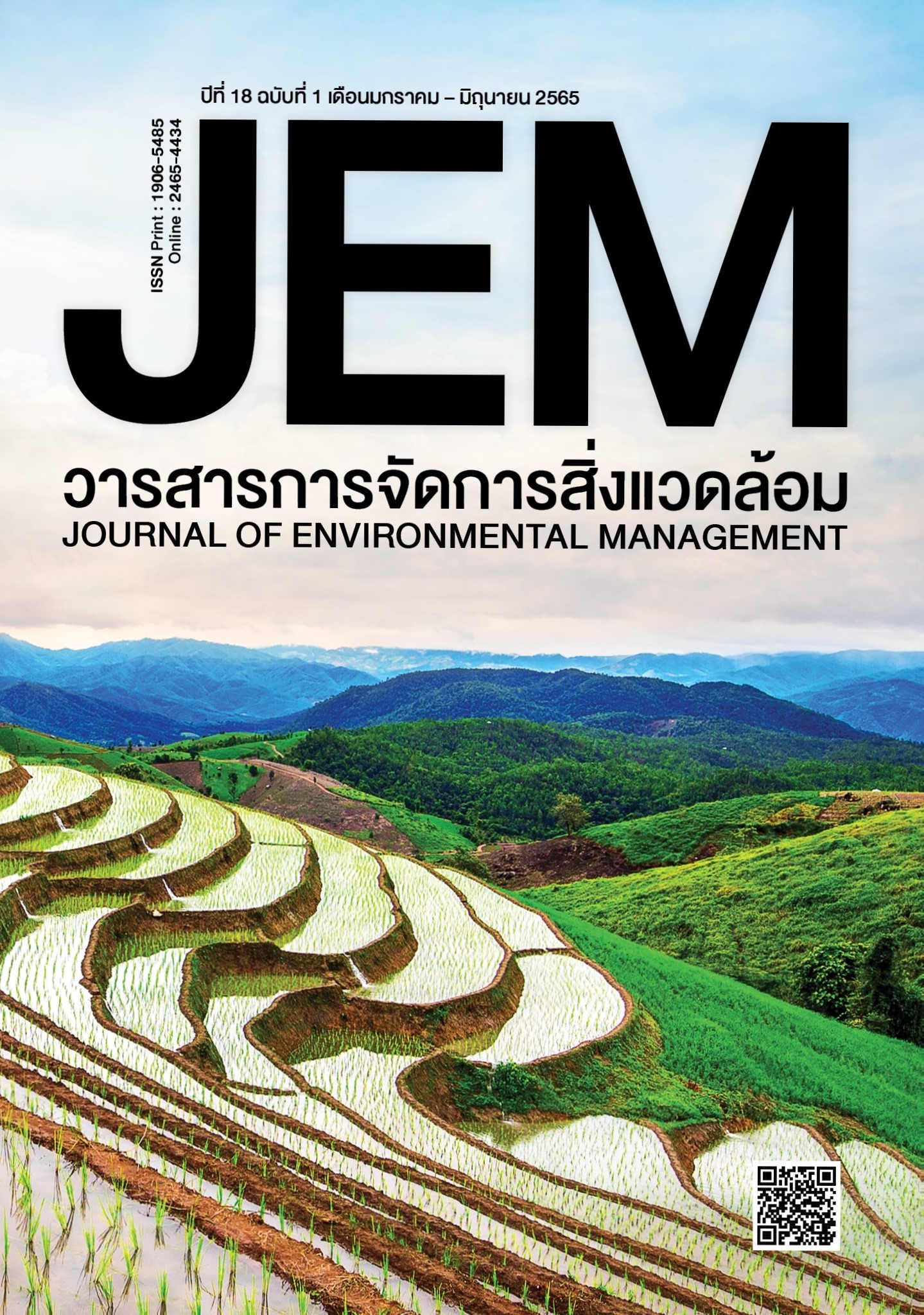GEOGRAPHICALLY AND TEMPORALLY WEIGHTED REGRESSION MODELS FOR GROUND-LEVEL PM2.5 ESTIMATION IN THAILAND
DOI:
https://doi.org/10.14456/jem.2022.3Keywords:
Ground-Level PM2.5 concentrations, Aerosol Optical Depth, Geographically and Temporally Weighted RegressionAbstract
This study aims to develop a geographically and temporally weighted regression (GTWR) model estimation for ground-level PM2.5 concentrations based on data from May 2014 to April 2019 in Thailand. The GTWR model was developed using aerosol optical depth (AOD) data, temperature (T), relative humidity (RH), wind speed (WS), and boundary layer height (BLH). The GTWR model can be defined by coefficient of determination (R2) 0.71, and root mean square error (RMSE) and mean absolute error (MAE) of 14.55 and 10.04 µg/m3, respectively, of the variability in ground-level PM2.5 concentrations. The correlation analysis indicates that PM2.5 has highest correlation with AOD and RH, followed by BLH, WS, and T, respectively. In addition, the GTWR test with measured data in dry season (April 2019), showed good performance more than wet season (October 2018) in model prediction with R2 of 0.76, RMSE of 18.32 µg/m3, and MAE of 14.20 µg/m3.
References
Bai, Y., Wu, L., Qin, K., Zhang, Y., Shen, Y., Zhou, Y. (2016). A geographically and temporally weighted regression model for ground-level PM2.5 estimation from satellite-derived 500 m resolution AOD. Remote Sensing, 8(3), 262.
Chavanaves, S., Fantke, P., Limpaseni, S., Attavanich, W., Panyametheekul, S., Gheewala, S. H., Prapaspongsa, T. (2021). Health impacts and costs of fine particulate matter formation from road transport in Bangkok Metropolitan Region. Atmospheric Pollution Research, 12(10), 101191.
Fotheringham, A. S., Brunsdon, C., Charlton, M. (2002). Geographically Weighted Regression: The Analysis of Spatially Varying Relationships. New York.
Guo, Y., Tang, Q., Gong, D. Y., Zhang, Z. (2017). Estimating ground-level PM2.5 concentrations in Beijing using a satellite-based geographically and temporally weighted regression model. Remote Sensing of Environment, 198, 140-149.
Gupta, P., Remer, L. A., Levy, R. C., Mattoo, S. (2018). Validation of MODIS 3 km land aerosol optical depth from NASA’s EOS Terra and Aqua missions. Atmospheric Measurement Techniques, 11, 3145-3159.
He, Q., Haung, B. (2018). Satellite-based high-resolution PM2.5 estimation over the Beijing-Tianjin-Hebei region of China using an improved geographically and temporally weighted regression model. Environmental Pollution, 236, 1027-1037.
Huang, B., Wu, B., Barry, M. (2010). Geographically and temporally weighted regression for modeling spatio-temporal variation in house prices. International Journal of Geographical Information Science, 24(3), 383-401.
Janjai, S. (2014). Solar Radiation [In thai]. Nakhon Pathom: Phetkasem Printing Group.
Kanabkaew, T. (2013). Prediction of Hourly Particulate Matter Concentrations in Chiangmai, Thailand Using MODIS Aerosol Optical Depth and Ground-Based Meteorological Data. EnvironmentAsia, 6(2), 65-70.
Kwanma, P., Pukngam, S., Arunpraparut, W. (2019). Meteorological factors affecting concentration of PM10 at Na Phra Lan Sub-district, Chaloem Phra Kiat District, Saraburi Province [In Thai]. PSRU journal of Science and Technology, 4(2), 85-94.
Li, T., Hu, R., Chen, Z., Li, Q., Huang, S., Zhu, Z., Zhou, L. F. (2018). Fine particulate matter (PM 2.5): The culprit for chronic lung diseases in China. Chronic Diseases and Translational Medicine, 4(3), 176-186.
Ma, Z., Hu, X., Huang, L., Bi, J., Liu, Y. (2014). Estimating ground-level PM2.5 in China using satellite remote sensing. Environmental Science & Technology, 48, 7436-7444.
Park, S., M. Shin, J. Im, C. K. Song, M. Choi, J. Kim, S. Lee, R. Park, J. Kim, D. W. Lee, S. K. Kim. (2019). Estimation of ground-level particulate matter concentrations through the synergistic use of satellite observations and process-based models over South Korea. Atmospheric Chemistry and Physics, 19, 1097-1113.
Pollution Control Department. (2019). Booklet on Thailand State of Pollution 2018. Bangkok: S.Mongkon Press Limited Partnership.
Pollution Control Department. (2022). National Ambient Air Quality Standards [In Thai]. Retrieved January 1, 2022, from http://air4thai.pcd.go.th/webV3/#/Download.
Remer, L. A., Mattoo, S., Levy, R. C., Munchak, L. A. (2013). MODIS 3 km aerosol product: algorithm and global perspective. Atmospheric Measurement Techniques, 6(7), 1829-1844.
Thai Meteorological Department. (2021). Thailand Weather [In Thai]. Retrieved October 10, 2021, from https://www.tmd.go.th/info/info.php?FileID=22.
Wei, J., Li, Z., Peng, Y., Sun, L. (2019). MODIS collection 6.1 aerosol optical depth products over land and ocean: validation and comparison. Atmospheric Environment, 201, 428-440.
You, W., Zang, Z., Zhang, L., Li, Y., Pan, X., Wang, W. (2016). National-scale estimates of ground-level PM2.5 concentration in china using geographically weighted regression based on 3 km resolution MODIS AOD. Remote Sensing, 8(3), 184.



